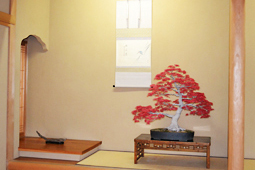 |
|
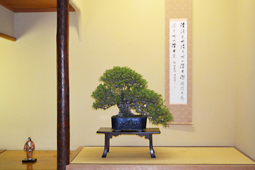 |
| The interior galleries are designed for ease of creating new displays. All the elements in the exhibits combine to produce an experience fitting to the season. |
|
The choice of scroll, plant, table, pot, and figure in each gallery is made daily. The selection, positioning, and balancing of elements can take most of the morning at the museum. |
A short walk from Mizue Station through the nondescript streets of Edogawa-ku delivers you to the gate of a hard-to-find oasis -- the Shunkaen Bonsai Museum. The museum feels nothing like a museum, but more like a home nestled in a typical east Tokyo neighborhood. After spending time inside, however, it feels like the entry point to the entire history, tradition and current practice of one of Japan's most special arts.
Inside the outer gate, bonsai on wooden stands line the garden pathways. These miniaturized trees come from all parts of Japan, with a few species from abroad. Some stand a meter tall, others are palm-sized, some hundreds of years old and others just sprouting. Flowering, deciduous and evergreen, the many shades of green set off by the knotty, intricate, rough-barked trunks show more variety than one could imagine possible.
Inside the house are eight or nine (depending on how the dividing shoji screens are moved) galleries specially designed to exhibit bonsai together with paintings, calligraphy, and ceramic objects. These galleries are the most museum-like part of the facility. Each of the tatami-floored rooms displays a mature bonsai, changed every day according to the season, the weather, and the mood of the curator.
The bonsai are placed together with a scroll, painting, poem, ceramic piece, figurine, or work of calligraphy. The vibrant interaction among these elements establishes a powerful scene. A bonsai pine tree combined with a painting of a moon and a small ceramic stupa creates a view from a Kyoto hilltop. A flowering bonsai together with a raucous poem about drinking and a miniature dancing Noh figurine evokes the hanami cherry blossom-viewing season.
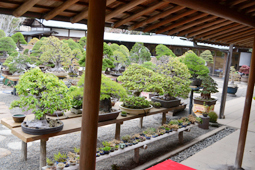 |
|
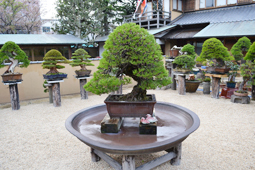 |
| The outdoor tables hold bonsai of all varieties. They grow in the sun and are watered and sprayed with insecticide to protect and maintain them. The small beginning plants are gradually transferred to increasingly larger pots. |
|
Many of the bonsai are several hundred years old, like this tree, which was recently pruned and repotted for display at the very center of the main garden area. |
The exhibit rooms weave along the glass front area of the long traditionally-designed house, passing through a tea ceremony room and smaller display areas before flowing up to the second floor. Upstairs, the museum houses a large collection of pots, ancient books detailing bonsai techniques and theories, and elaborately carved tables. Turn around from any one of the galleries and the garden, with its hundreds of bonsai, running water, rocks and pond, waits just outside.
The museum is the creation of Kunio Kobayashi, who has perhaps won more prizes than any other living bonsai master. He opened the museum in 2002 for the purpose of promoting the art and culture of bonsai. Kobayashi also hosts a TV show and travels the world giving lectures, demonstrations and workshops at bonsai associations in Italy, Britain, Germany, America and China. Students from England and Germany have stayed with him for years, living and learning from him. When he wants inspiration, though, Kobayashi heads for the mountains around Tokyo to study the way plants grow in their natural settings.
The museum has room for classes, consultations, repair work, and five apprentices who live, study and work there in the classical Japanese way. The workshop and office near the front gate are delightfully messy, a perfect counterpoint to the pristine galleries and perfectly trimmed plants. The workshop is packed with various mixtures of dirt and charcoal, fertilizers, and plant food, as well as hundreds of tools specific to the detailed techniques that the art of bonsai entails.
Sitting on the tatami contemplating the displays, wandering the garden, and poking around the tools, dirt, and pruning tables lets the visitor experience the full power, complexity and beauty of bonsai. Taking a leisurely stroll through the grounds gives one time to consider how even a bonsai master is really only a short-term caretaker for a work of art to which many artists have contributed in the past and to which others will add in the future. The Shunkaen Bonsai Museum is a living museum for a living art.
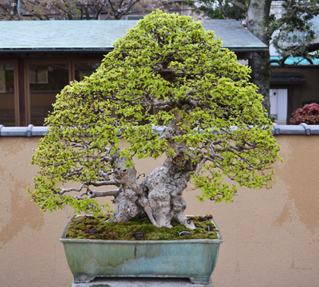 |
|
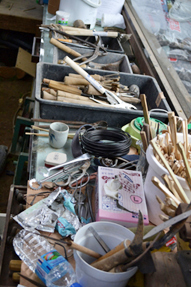 |
In addition to the length, direction and shape of limbs and leaves, the bark and moss require a great deal of attention, and their growth is carefully monitored for decades.
|
|
The workshop area has multiple worktables and a vast selection of tools, each of which performs a special function.
All photos by Michael Pronko, by permission of Shunkaen Bonsai Museum
|
|